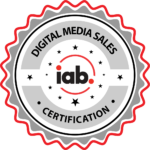Digital marketing can sometimes feel like an uphill battle for small and medium-sized businesses, especially when resources are limited.
However, programmatic display advertising offers a way for businesses of all sizes to connect with their audience more efficiently and effectively.
If terms like programmatic display, geo-fencing, and audience targeting seem unfamiliar, you’re not alone. In this article, we’ll break down these concepts in straightforward terms and explain how they can enhance your marketing efforts.
Let’s get started.
What is Programmatic Display, and Why Should You Care?
Let’s start with the basics – what exactly is programmatic display?
Simply put, it’s a way to automatically buy and sell digital ad space using technology instead of traditional, often tedious, manual methods. Think of it like the stock market, but instead of trading shares, you’re trading ad placements across websites, apps, and social media platforms.
So, why should you care? Because programmatic display is like having a marketing team that works 24/7, making sure your ads get in front of the right people at the right time. For small to medium-sized businesses, this means you can compete with larger companies without needing a massive budget or a dedicated in-house team.
How Programmatic Display Works in Plain English
Here’s how it all works.
When someone visits a website, an automated auction happens in the blink of an eye. Different advertisers bid to show their ad to that specific visitor, and the highest bidder wins. The winning ad is then displayed on the page. This all happens in milliseconds, and it’s repeated millions of times every day across the web.
The magic of programmatic display lies in the data. By using data about who your ideal customers are – things like their age, interests, and online habits – you can target your ads more precisely than ever before. This means your ads aren’t just seen by anyone – they’re seen by people who are likely to be interested in what you’re offering.
Utilizing Audience Targeting and Retargeting With Your Campaigns
Every great marketing campaign starts with understanding who you’re trying to reach.
With audience targeting, you’re essentially narrowing down the pool of people who will see your ads. Instead of casting a wide net, you’re fishing in a well-stocked pond.
Different Ways to Target Your Audience
There are several ways to go about targeting your audience.
- Demographic Targeting: Want to reach middle-aged homeowners in Michigan? No problem. With demographic targeting, you can focus on specific groups of people based on characteristics like age, gender, income, or education level.
- Interest Targeting: If your product appeals to dog lovers or avid gardeners, interest targeting lets you reach those specific audiences by focusing on what they care about.
- Behavioral Targeting: This method targets people based on their past online behavior—like the websites they visit or the things they’ve bought before. If someone’s been looking at a lot of vacation packages, you can serve them ads for your travel-related product or service.
- Contextual Targeting: This approach puts your ads on websites relevant to your product or service. For example, if you sell sports equipment, your ads could appear on sports news sites or fitness blogs.
Types of Retargeting For Your Audience
Retargeting involves creating touchpoints that will remind potential users of products or services they might be interested in after leaving your website. Here are some types of retargeting to try.
- Site Retargeting: Want to retarget users who have left your site? Site retargeting does just that by displaying your relevant ads to these users as they continue to browse the internet.
- Product Retargeting: If a potential customer is looking for a product online and visits your site to look at the product, retargeting can be used. As the potential customer continues to browse the internet they will be shown relevant ad products.
- Shopping Retargeting: This method targets potential customers who have already made a purchase or abandoned a shopping cart. By using email marketing you can retarget this user by sending emails such as a reminder to complete their purchase.
- Search Retargeting: This type of retargeting targets users who have previously searched specific keywords related to your business such as a product or service. As users continue to browse the internet, they will be shown relevant ads related to those keywords about your business.
By combining these different methods, you can create ads that speak directly to the people who are most likely to become your customers.
How Geo-Fencing and Microproximity Can Supercharge Local Marketing
If your business relies on local customers – whether you’re a coffee shop, a retail store, or a real estate agency – geo-fencing and microproximity should be on your radar.
These tools take location-based marketing to a whole new level.
What is Geo-Fencing?
Picture this: you’ve drawn an invisible boundary around your store or office, and every time someone with a smartphone enters that area, they get served an ad for your business.
That’s geo-fencing in a nutshell. It’s a way to target people based on their physical location in real-time.
For example, if you own a restaurant, you can set up a geo-fence around your neighborhood and send special offers to people when they’re nearby. This makes your ads highly relevant because they’re reaching people who are close enough to take immediate action.
Going Even Deeper with Microproximity
Microproximity is like geo-fencing but even more precise.
Instead of targeting a whole neighborhood, you can target a specific area within a complex or shopping center.
Imagine this: a customer walks into your store and, as they move through different sections, they receive notifications about discounts on the items they’re closest to. That’s microproximity in action. It’s incredibly powerful for businesses that want to engage customers right when they’re making purchasing decisions.
Device ID: Reaching Your Audience Across Multiple Devices
We live in a multi-device world.
People might start researching a product on their phone during their commute, continue browsing on their tablet at home, and finally make a purchase on their laptop. This is where Device ID targeting comes in handy.
What is Device ID, and How Does it Work?
Every mobile device has a unique identifier called a Device ID. This ID allows marketers to follow users across different devices, ensuring that their ads are seen whether the user is on their smartphone, tablet, or computer.
For SMBs, this means you can create a consistent experience for your customers across all the devices they use. If someone sees your ad on their phone but doesn’t take action right away, you can retarget them later on their laptop. This cross-device strategy keeps your brand top of mind and increases the chances of converting a lead into a customer.
Integrating Programmatic Display into Your Marketing Strategy
Now that you have a better understanding of programmatic display and how it works, the next step is to figure out how to integrate it into your overall marketing strategy.
Why a Holistic Approach Matters
A strategy that combines multiple channels and tactics is important to maximize marketing efforts.
Programmatic display is powerful, but it’s even more effective when it’s part of a broader plan that includes SEO, social media, email marketing, and more.
Here’s how programmatic display can enhance your marketing strategy:
- Reach a Broader Audience: Programmatic display ads can appear on thousands of websites and apps, giving you access to a vast audience.
- Increase Relevance: With advanced targeting, your ads are more likely to be seen by people who are actually interested in your products or services.
- Optimize your Budget: Automated bidding and placement ensure that your ad spend is used efficiently so you get the most bang for your buck.
- Create a Cohesive Campaign: When combined with other marketing efforts, programmatic display helps reinforce your brand message across different platforms.
Getting Started with Programmatic Display
If you’re ready to dip your toes into the world of programmatic display, here’s a simple roadmap to follow:
- Set Clear Goals: What do you want to achieve? Whether it’s increasing brand awareness, driving sales, or generating leads, having a clear goal will guide your campaign.
- Know Your Audience: Use the targeting options we discussed earlier to define who you want to reach. The more specific you are, the better your results will be.
- Choose the Right Platform: There are plenty of programmatic platforms available. Pick one that suits your needs and offers features that align with your goals.
- Create Engaging Ads: Your ads need to grab attention and speak directly to your audience. Experiment with different formats, such as banners, videos, and native ads, to see what works best.
- Monitor and Adjust: Keep an eye on how your ads are performing. Use the data to tweak and improve your campaign as you go along.
Wrapping it Up: The Future of Digital Marketing for Small to Medium-Sized Businesses
If you’re ready to take your digital marketing to the next level, programmatic display is a great place to start. Contact us today to learn more about how we can help you craft a winning digital marketing strategy.























